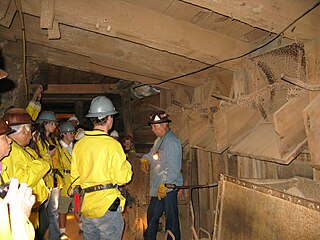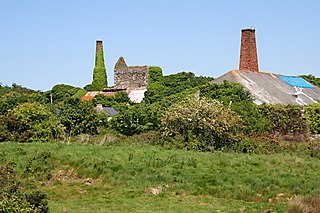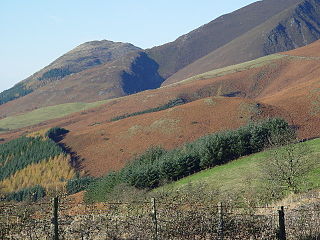
Coniston Water is a lake in the Lake District in North West England. It is the third largest by volume, after Windermere and Ullswater, and the fifth-largest by area. The lake has a length of 8.7 kilometres, a maximum width of 730 metres (800 yd), and a maximum depth of 56.1 m. Its outflow is the River Crake, which drains into Morecambe Bay via the estuary of the River Leven. The lake is in the unitary authority of Westmorland and Furness, and the ceremonial county of Cumbria.
William Humfrey (c.1515–1579) was an English goldsmith, mining promoter, and Assay Master at the Royal Mint during the reign of Elizabeth I.

Swansea is a ghost town in La Paz County in the U.S. state of Arizona. It was settled circa 1909 in what was then the Arizona Territory. It served as a mining town as well as a location for processing and smelting the copper ore taken from the nearby mines.

Copper extraction refers to the methods used to obtain copper from its ores. The conversion of copper ores consists of a series of physical, chemical and electrochemical processes. Methods have evolved and vary with country depending on the ore source, local environmental regulations, and other factors.
Joachim Gans was a Bohemian mining expert, renowned for being the first Jew in North America.

Charles Roe was an English industrialist. He played an important part in establishing the silk industry in Macclesfield, Cheshire and later became involved in the mining and metal industries.
The Society of the Mines Royal was one of two English mining monopoly companies incorporated by royal charter in 1568, the other being the Company of Mineral and Battery Works.

The Höchstetter family, from Höchstädt in western Bavaria near the banks of the Danube, were members of the fifteenth and sixteenth-century mercantile patriciate of Augsburg.

The Copper Queen Mine was a copper mine in Cochise County, Arizona, United States. Its development led to the growth of the surrounding town of Bisbee in the 1880s. Its orebody ran 23% copper, an extraordinarily high grade. It was acquired by Phelps Dodge in 1885.
Granby Consolidated Mining, Smelting and Power Co. was established by charter to operate in the Boundary region of southern British Columbia. Primarily involved in the mining and smelting of copper, the conglomerate became a publicly traded company. The various corporate operating names within the former group mostly specified the Granby identity.

Wheal Busy, sometimes called Great Wheal Busy and in its early years known as Chacewater Mine, was a metalliferous mine halfway between Redruth and Truro in the Gwennap mining area of Cornwall, England. During the 18th century the mine produced enormous amounts of copper ore and was very wealthy, but from the later 19th century onwards was not profitable. Today the site of the mine is part of the Cornwall and West Devon Mining Landscape, a UNESCO World Heritage Site.

Underskiddaw is a civil parish in the Borough of Allerdale in the English county of Cumbria. The parish lies immediately to the north of the town of Keswick, and includes the southern and eastern flanks of Skiddaw as well as part of the valley of the rivers Greta and Derwent, and a small part of Bassenthwaite Lake. The parish includes the settlements of Applethwaite, Millbeck and Ormathwaite, all of which lie along the line where the southern slopes of Skiddaw meet the valley.
Burchard Kranich was a mining engineer and physician who came to England from Germany. He was involved in mining ventures in Derbyshire and Cornwall, and in assaying the black ore, thought to be gold-bearing, brought back to England from Baffin Island by Martin Frobisher. He later practised as a physician in London, where he enjoyed a mixed reputation, and is said to have attended Elizabeth I when she contracted smallpox. He is alluded to in several literary works published during the reigns of Elizabeth I and James I.

The Coniston copper mines were a copper mining operation in Lancashire, England. It was functional for hundreds of years in Coppermines Valley above Coniston Water. Today there are industrial remains of the industry and the Coniston Coppermines Youth Hostel is based in the old manager's building.
The German mines at Caldbeck were part of the operations of the Company of Mines Royal in Caldbeck, which introduced German miners from modern day Austria and Bavaria into the Lake District in 1563, though earlier works in the area are thought to have been begun in the 1300s. The importance of the operation lies in its historical significance as the first large-scale copper mining and smelting operation in the British Islands which was well-documented. New smelting techniques were introduced which were allowed the treatment of argentiferous copper sulphide ores and the more complex lead-copper-silver ores from Caldbeck.

Cornelius de Vos or de Vois or Devosse, was a Dutch or Flemish mine entrepreneur and mineral prospector working in England and Scotland. He was said to have been a "picture-maker" or portrait artist. De Vos is known for gold mining in Scotland and founding saltworks at Newhaven near Edinburgh.
George Bowes was an English prospector. He mined for gold in Scotland.

Gold has been mined in Scotland for centuries. There was a short-lived gold rush in 1852 at Auchtermuchty and Kinnesswood, and another in 1869 at Baile An Or on the Kildonan burn in Helmsdale in Sutherland. There have been several attempts to run commercial mines. In the Lowther Hills, Leadhills, and Wanlockhead areas gold prospecting and the extraction of lead metal went hand in hand. From 1424, under the Royal Mines Act, until 1592, gold and silver mined in Scotland were deemed to belong to the crown. The 1592 Act vested rights for gold, silver, lead, copper, tin, and other minerals in the king's feudal tenants or other leaseholders, who would pay 10% of any profit to the crown. The Act also established a Master of Metals as a crown officer, a position held from June 1592 by Lord Menmuir. followed by Thomas Hamilton of Monkland in March 1607.
Richard Dudley of Yanwath (1518–1593) was an English landowner involved in copper and silver mines in the north of England from 1570 onwards.

Thomas Thurland was Master of the Savoy Hospital in London and a mining entrepreneur. His family was from Nottinghamshire.














